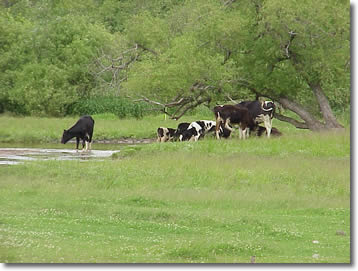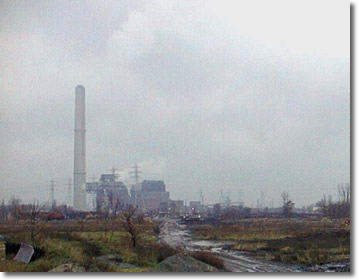Watershed Threats


General Watershed Information | Watershed Threats | How You Can Help | Watershed Resources
Nonpoint Source Pollutants
Point Source Pollutants
Cattle in a stream is a nonpoint source of
bacteria and nutrients in waterways.
A pollutant is any substance of such character and in such quantities that when it reaches a body of water, soil, or air, it contributes to the degradation or impairment of its usefulness or renders it offensive. Nonpoint source pollution is pollution that is caused when rain, snowmelt, or wind carry pollutants off the land and into the waterbodies.
In contrast to point source pollution, nonpoint source pollution comes from many different diffuse sources and is extremely difficult to regulate and control; therefore, many experts believe that NPS pollution is the top hazard facing the Great Lakes today.
Typical Nonpoint Source Pollutants Impacting Michigan Waters
- Excess fertilizers, herbicides, and insecticides from agricultural lands and residential areas;
- Oil, grease, and toxic chemicals from urban runoff and energy production;
- Sediment from improperly managed construction sites, crop and forest lands, and eroding streambanks;
- Salt from irrigation practices and acid drainage from abandoned mines;
- Bacteria and nutrients from livestock, pet wastes, and faulty septic systems;
- Atmospheric deposition are also sources of nonpoint source pollution.
Point source pollutants come from industrial water discharges.
A pollutant is any substance of such character and in such quantities that when it reaches a body of water, soil, or air, it contributes to the degradation or impairment of its usefulness or renders it offensive. Point source pollution is the release of an effluent form a pipe or discrete conveyance into a waterbody or watercourse leading to a body of water.
Industrial water discharges and sewage treatment plants are the main culprits of this type of pollution. Point source pollutants can include many different organic and inorganic substances, including human waste and toxic metals.
Point source pollution can be traced to a specific discharge point and owner; therefore, it has been the easiest source of pollution to control and regulate. Since the Clean Water Act of 1972, nearly 100 percent of all industrial plants use control measures to reduce their toxic discharge, and the number of sewage treatment facilities has doubled.
